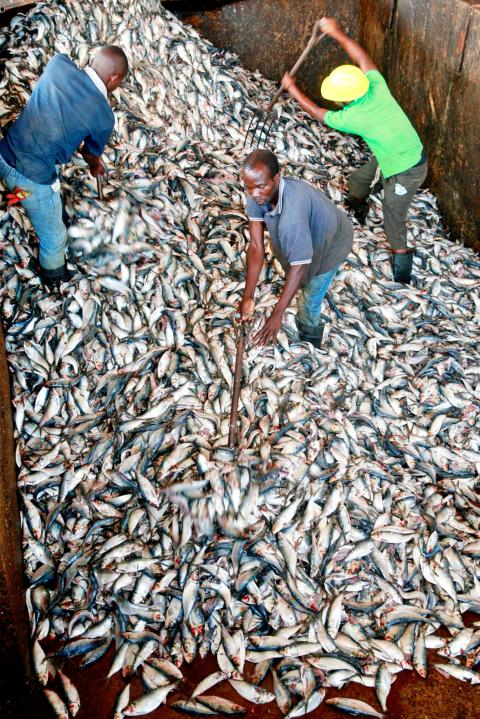Unbridled consumption has decimated global wildlife, triggered a mass extinction and exhausted Earth’s capacity to accommodate humanity’s expanding appetites, the conservation group WWF said yesterday.
From 1970 to 2014, 60 percent of all animals with a backbone — fish, birds, amphibians, reptiles and mammals — were wiped out by human activity, according to WWF’s Living Planet report, based on an ongoing survey of more than 4,000 species spread over 16,700 populations scattered across the globe.
“The situation is really bad, and it keeps getting worse,” WWF International director-general Marco Lambertini said.

Photo: AFP
“The only good news is that we know exactly what is happening,” he said.
For freshwater fauna, the decline in population over the 44 years monitored was a staggering 80 percent.
Regionally, Latin America was the hardest hit, seeing a nearly 90 percent loss of wildlife over the same period.
Another dataset confirmed the depth of an unfolding mass extinction event, only the sixth in the past half-billion years. Depending on which of Earth’s lifeforms are included, the current rate of species loss is 100 to 1,000 times higher than only a few hundred years ago, when people began to alter Earth’s chemistry and crowd other creatures out of existence.
Measured by weight, or biomass, wild animals today only account for 4 percent of mammals on Earth, with humans (36 percent) and livestock (60 percent) making up the rest.
Ten thousand years ago that ratio was probably reversed.
“The statistics are scary,” said Piero Visconti, a researcher at the International Institute for Applied Systems Analysis in Austria and one of 59 coauthors of the 80-page report.
“Unlike population declines, extinctions are irreversible,” he said.
For corals, it may already be too late.
Back-to-back marine heatwaves have already wiped out up to half of the globe’s shallow-water reefs, which support a quarter of all marine life.
Even if humanity manages to cap global warming at 1.5oC — mission impossible, according to some scientists — coral mortality is likely to be 70 to 90 percent.
A 2oC world would be a death sentence, a major UN report concluded last month.
Half-a-century of conservation efforts have scored spectacular successes, with significant recoveries among tigers, manatees, grizzly bears, bluefin tuna and bald eagles.
“If we didn’t make those efforts, the situation would have been much worse,” Lambertini said.
However, the onslaught of hunting, shrinking habitat, pollution, illegal trade and climate change — all caused by humans — has been too much to overcome, he said.
“Scientists call it the ‘great acceleration,’” he said in a phone interview. “It is the exponential growth over the last 50 years in the use of energy, water, timber, fish, food, fertilizer, pesticides, minerals, plastics — everything.”
The pace of population increase — long taboo in development and conservation circles — also took off around 1950, the date scientists have chosen as the “gold spike,” or starting point, for a new geological period dubbed the Anthropocene, or “age of man.”
In looking for answers, conservationists are turning to climate change for inspiration.
“We need a new global deal for nature,” Lambertini said, adding two key ingredients in the 195-nation Paris climate treaty.
“One was the realization that climate change was dangerous for the economy and society, not just polar bears,” he said.
Similarly, threatened ecosystem services long taken for granted — drinkable water, breathable air, heat-absorbing oceans, forests that soak up carbon dioxide, productive soil — are worth tens of trillions of dollars every year, he said.
“A healthy, sustainable future for all is only possible on a planet where nature thrives and forests, oceans and rivers are teeming with biodiversity and life,” Lambertini said.

POLITICAL PRISONERS VS DEPORTEES: Venezuela’s prosecutor’s office slammed the call by El Salvador’s leader, accusing him of crimes against humanity Salvadoran President Nayib Bukele on Sunday proposed carrying out a prisoner swap with Venezuela, suggesting he would exchange Venezuelan deportees from the US his government has kept imprisoned for what he called “political prisoners” in Venezuela. In a post on X, directed at Venezuelan President Nicolas Maduro, Bukele listed off a number of family members of high-level opposition figures in Venezuela, journalists and activists detained during the South American government’s electoral crackdown last year. “The only reason they are imprisoned is for having opposed you and your electoral fraud,” he wrote to Maduro. “However, I want to propose a humanitarian agreement that

ECONOMIC WORRIES: The ruling PAP faces voters amid concerns that the city-state faces the possibility of a recession and job losses amid Washington’s tariffs Singapore yesterday finalized contestants for its general election on Saturday next week, with the ruling People’s Action Party (PAP) fielding 32 new candidates in the biggest refresh of the party that has ruled the city-state since independence in 1965. The move follows a pledge by Singaporean Prime Minister Lawrence Wong (黃循財), who took office last year and assumed the PAP leadership, to “bring in new blood, new ideas and new energy” to steer the country of 6 million people. His latest shake-up beats that of predecessors Lee Hsien Loong (李顯龍) and Goh Chok Tong (吳作棟), who replaced 24 and 11 politicians respectively

Young women standing idly around a park in Tokyo’s west suggest that a giant statue of Godzilla is not the only attraction for a record number of foreign tourists. Their faces lit by the cold glow of their phones, the women lining Okubo Park are evidence that sex tourism has developed as a dark flipside to the bustling Kabukicho nightlife district. Increasing numbers of foreign men are flocking to the area after seeing videos on social media. One of the women said that the area near Kabukicho, where Godzilla rumbles and belches smoke atop a cinema, has become a “real

‘WATER WARFARE’: A Pakistani official called India’s suspension of a 65-year-old treaty on the sharing of waters from the Indus River ‘a cowardly, illegal move’ Pakistan yesterday canceled visas for Indian nationals, closed its airspace for all Indian-owned or operated airlines, and suspended all trade with India, including to and from any third country. The retaliatory measures follow India’s decision to suspend visas for Pakistani nationals in the aftermath of a deadly attack by shooters in Kashmir that killed 26 people, mostly tourists. The rare attack on civilians shocked and outraged India and prompted calls for action against their country’s archenemy, Pakistan. New Delhi did not publicly produce evidence connecting the attack to its neighbor, but said it had “cross-border” links to Pakistan. Pakistan denied any connection to